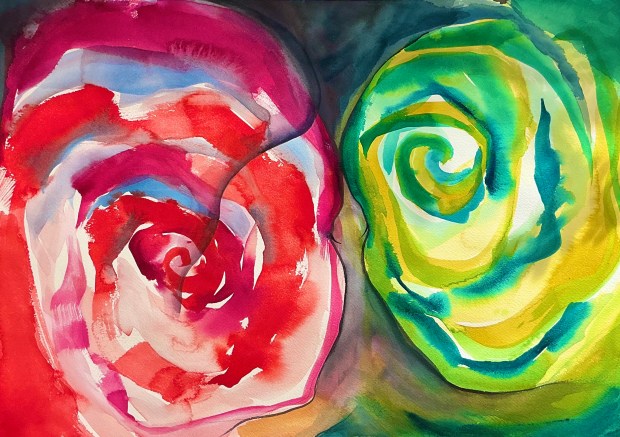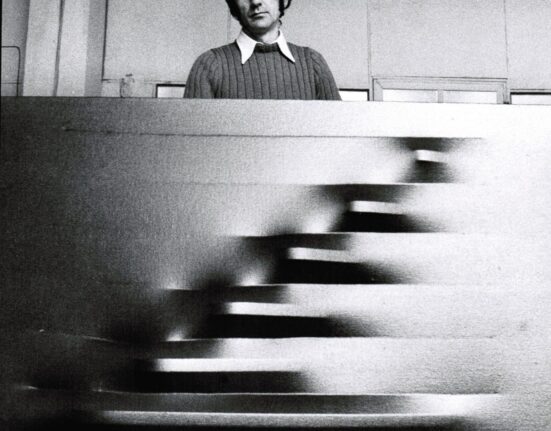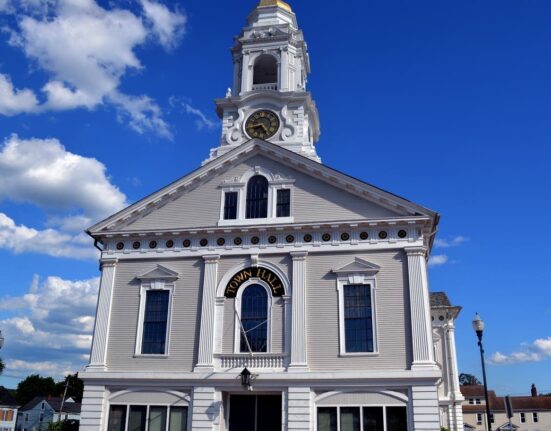This weekend, art lovers can step into a backyard filled with mosaics, a kitchen turned into an art studio, or a sunny living room lined with watercolor dreams.
The East Boulder County Artists Spring Studio Tour is back for its 27th year, with 49 artists opening their doors to the public across Longmont, Lafayette, Louisville and Niwot. The free, self-guided tour offers a rare chance to meet the makers, see works of art in progress and get a glimpse into the spaces where creativity is born.
The event is organized by East Boulder County Artists, a nonprofit collective that’s entirely artist-run. That means the same folks who are sculpting, soldering, painting and printing are also behind the emails, maps and logistics that bring the tour to life.
What began as a few neighbors showing off their basement studios has grown into a thriving 501(c)(3) with a mission rooted in education, outreach and community connection. These days, EBCA includes nearly 100 member artists, though not all participate in the yearly tour.
This spring, about half of the artists are opening their studios to the public as part of the event.
“It started with just a small group of artists who wanted their neighbors to know there were creatives living among them,” said Joyanna Gittings, EBCA president and a participating artist. “They wanted to share what they were making, not in a formal gallery, but right from the spaces where they were creating it. That was the spark. And now we have 49 artists and 34 locations this year. I am not sure if that is the most we have ever had, but it is close.”

A few years ago, EBCA merged with Arts Longmont, another local organization that used to run its own studio tour. Folding the two groups together brought more artists and more diversity into the mix, without losing the grassroots feel that defines the event.
“We have tried really hard not to let it get too polished or overly programmed,” Gittings said. “We are still volunteer-run, and that is on purpose. Everyone chips in to help with logistics, brochures and outreach. I think that’s part of why the tour still feels so personal. You walk into a studio and meet the person who helped hang the signs. It is art, and it is also community.”
The tour invites you into the rooms, garages, garden sheds and converted dining nooks where that work begins. Some spaces are immaculate, others are charmingly chaotic and all of them are the real deal.
Over two days, visitors can see demonstrations, ask questions, peek at pieces mid-process, and meet the people behind the paint. It is less about the final product and more about the beautiful, messy, experimental process that gets you there.
“What I love is seeing the artist and the space together,” Gittings said. “You get to see the tchotchkes, the tools, the little things they surround themselves with. A lot of times those objects have nothing to do with the art they are making, and that is what makes it so fascinating. You learn about the person behind the work just by standing in their studio.”
Gittings’ own studio, located in a retail space on Longmont’s Main Street, will be part of the tour again this year. Inside, she will unveil a new abstract series — work that is a little more emotional and less structured than her previous collections.
“I am excited and a little nervous to show it,” she said. “It is definitely a different direction for me, but that is kind of the point of this tour. People get to see the in-between stages, the experiments, the stuff that is still unfolding.”
Her studio will also include a collaborative community piece that visitors can help create. The setup is simple: Grab a brush, add a mark and contribute to something collective. It is a project Gittings has led at previous events, and one she said always sparks joy.
“By the end of the weekend, we will have a brand-new piece of art made by everyone who came through the door,” she said. “It is just a really fun way for people to not only see art, but to participate in it.”

At another art studio, Longmont-based artist Jacqueline Jones Bahr creates pieces that are equal parts precise and playful. Her work includes sun catchers, candle boxes and small sculptural forms, often with clean lines, bold color and a dose of origami-inspired geometry.
Bahr didn’t always plan to become a stained-glass artist, but once she found the medium, it stuck.
“I started out doing woodworking years ago at community college, but realized pretty quickly that I didn’t have the space or the money to buy all the big tools,” Bahr said. “You need a planer, a jointer, a lot of heavy equipment. Around that same time, I saw that there was a stained-glass class being offered. I thought, ‘Well, this looks like it uses smaller tools.’ So I signed up. And I was hooked.”
That was 20 years ago. Since then, Bahr has built a studio practice under the name Lighten Up Stained Glass, where she explores color, texture and dimension through small- and medium-sized works. A signature part of her process is translating origami forms into glass — folding patterns into rigid structure and capturing the spirit of paper in something much more permanent.
“I love the challenge of it,” she said. “Glass doesn’t fold. So you have to figure out how to keep the feeling of origami without being literal. I want people to look at a piece and say, ‘Oh, I recognize that form,’ even if it is made entirely out of cut and soldered glass.”
Bahr has participated in the EBCA Studio Tour several times before, and while she does not do live demos (flying glass shards and curious fingers are not the safest combination), her studio setup is built to walk visitors through the process. She lays out works in various stages of completion, so people can see everything from design to cutting to final polish.
She also loves to talk. Not just about her work, but about how stained glass can be more approachable than people think.
“People say, ‘I’m not very creative,’ and I say, ‘Just because you don’t see it in yourself doesn’t mean it’s not there’,” Bahr said. “Everyone has a way of expressing themselves. I just help them find it.”
Bahr teaches stained-glass classes through the Longmont Recreation Center and offers private lessons for those who prefer a quieter, one-on-one approach. She brings all the tools, all the materials and a healthy dose of encouragement.
And lately, her journey has shifted. Bahr shared that she’s living with Parkinson’s disease, and that it has changed how she works in the studio — but it hasn’t slowed her down.
“I have tremors in my left hand, and it’s been a challenge,” she said. “But I want people to know: Don’t let it stop you. You can always work around it. My art may look a little different now, but I don’t think it’s worse. You adapt. You keep going.”
Visitors can see Bahr in all her stained-glass glory on the tour at 1020 Bross St., Longmont.

Like Bahr, artist Suzanne Frazier did not start her career in what she’s ended up doing. Long before she was layering oil paint colora onto canvas in her Longmont studio, she was climbing the ranks in radio and airline public relations, holding roles at 630 KHOW, Denver’s talk radio, and Frontier Airlines. She had a philosophy degree, a sharp mind and a clear ceiling above her.
“In the early ’70s, I was told I would never be a professor because I was a woman,” she said. “Back then, there was no way to fight that.”
Instead, she pivoted. She worked in promotions, built a career, and then, at age 40, walked back into a classroom — this time, though, an art classroom. She enrolled in a summer course at the University of Denver, taught by the head of the art department. Halfway through the session, he called her in.
“He asked why I wasn’t taking the class for credit,” she said. “I told him I already had a degree. And he said, ‘Well, I’ve changed it to credit and accepted you into the program.’ That’s how I got into art school.”
Frazier now calls herself a “contemplative artist,” a term she coined to describe her process that is rooted in meditation, mindfulness and emotional response. Her work is abstract, sometimes landscape-adjacent, and often built in layers. She paints what she feels, and her practice begins with breath.
“Painting isn’t about making products,” she said. “It’s a way to express my personal path. I don’t say people buy my paintings. I say they adopt them.”
Her studio, which also doubles as a classroom during the week, transforms into a gallery for the tour. Every wall is lined with new work, and there is always one piece still in progress — just enough to spark conversation.
“It’s a sacred space when I’m teaching, but I reconfigure it for the tour,” she said. “That shift in energy is something I really enjoy. I love meeting people and hearing what they see in the work.”
Frazier often asks visitors to share their reactions.
“I always ask people, ‘What do you see in this painting?’ she said. “Years ago, I had a mountain landscape, and a man came in and said, ‘Oh, that’s Mount so-and-so. I climbed that mountain!’ But I had, actually, not painted that mountain. I had never even heard of the mountain.
“People will see something from their own life in the work, especially if it’s abstract or open-ended. They attach their own story to it.”
Frazier said she’s learned so much from people’s reactions and stories.

“Paintings are like Rorschach tests,” she said. “Everyone sees something different, and it becomes a conversation. I learn something new every time.”
Tour-goers can find Frazier tucked upstairs at 1515 Main St., Suite 201, in Longmont, ready to hear what you see in her work, whether it’s a memory, a mountain, or something in between.
According to Gittings, one of the things that makes the EBCA Studio Tour feel so personal is the sheer variety of artists involved. This year’s lineup includes everyone from longtime professionals to first-time exhibitors, from oil painters with decades of experience to newer artists just beginning to share their work with the public.
“That range is really special,” she said. “You get to meet people where they are, and you walk away with more than just a piece of art…You walk away with a story.”
Many artists help organize the tour while also mentoring others, sharing resources, or simply showing up to cheer each other on.
“Being around people who think creatively, it opens your world,” said Bahr. “You realize you’re not on this path alone.”
Frazier agrees. She has been a part of EBCA since 2013 and said that for many artists, the group feels less like an organization and more like a circle of friends.
“We hug when we see each other. We ask about each other’s kids,” she said. “It’s not competitive — it’s warm and supportive, because everyone is doing something different, and everyone understands that art needs a warm environment to thrive.”
The East Boulder County Artists Spring Studio Tour runs from 10 a.m. to 5 p.m. Saturday and Sunday. The tour is free and open to the public, with 49 artists showing work at 34 locations across east (and north) Boulder County. Visitors are encouraged to bike or carpool if possible, and to bring a mask along, as some studios may request them.
Studio maps are available at various community hubs, including Old Town Marketplace in Longmont, The Great Frame Up, local libraries and participating sponsor businesses. Each studio on the tour will also have maps for those exploring in real time.
For more information, visit ebcacolorado.org.












